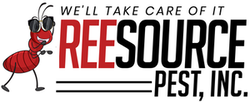There are two main species that we have in our area – the House mouse and the Fieldmouse. They both have similar biologies and reproductive potential.
The House mouse is uniformly gray in color across the entire body and tail. They average in size of about 3″ long in the body with an average tail length of about 3-4″ long. They typically weigh about 1/2oz-1oz. They have pointed muzzles, small eyes, and large ears. Field mice have a pointed muzzle, large beady eyes, large ears, and will have a bright white belly and a brown to dark grey body. The tail is also distinctly bi-colored – dark on top and white on the bottom.
Field mice are often closely associated with wooded areas and fields. They love to climb up high and enter structures from up high. They have similar body sizes and weight as the House mouse but oftentimes can be a bulkier and heavier mouse. Both species can be found living well outside both in suburban and in urban areas. Mice enter structures via open utility penetrations and gaps at the bottoms of exterior doors bigger than a 1/4″ are easy entry points for mice to utilize. There are many more specific entry points that mice can use to get inside that can be listed here but the basic rule of thumb is to exclude (seal) gaps and holes in the exterior walls of the structure. Materials used that work best are things like copper mesh and foam or stainless steel mesh with foam or caulk is a good way to go about it. Galvanized metal hardware cloth (1/4″ sized squares) and sheet metal are commonly used by us professionals for exclusion work.
Inside the structure – trapping of mice already in the home is very important to ensure they don’t attempt to chew through sealed areas. There are a wide array of mouse traps out there to choose from. Snap traps are very effective when placed properly. Glue traps are widely used but adult mice are often strong enough to get off of them making them become trap shy. Mice, once inside a structure, do not head back outside. They are primarily nocturnal and are naturally curious animals. They have poor vision and are colorblind. They use their whiskers along hard surfaces and are dropping drops of urine and pheromones as they travel in search of food and nesting materials. Mice will put out around 50 droppings or more a day. Water is not a critical factor for mice as they have the unique ability to metabolize water from the foods they consume. They’ll readily drink it though when available.
Clutter is their friend so decluttering or organizing things in plastic totes with lids is recommended. All foodstuffs should be stored in a tightly sealed container or if it can be – refrigerated. Inside, mice will travel via wall voids, pipe chases, expansion joints and etc. Exclusion of holes around pipe/utility line penetrations, holes chewed through walls, gaps along floor/wall junctions, raised flooring penetrations are all examples of what we’d look for to seal up for mice. In attics, there may be a need to screen the gable vents or other penetrations at the soffits. Nylon bristle type door sweeps are exceptional at keeping mice out and there are similar products available for excluding gaps on the bottoms of garage doors and overhead doors in industrial places.
On the exterior – weighted rodent bait stations can be utilized to further control mouse populations outside. Inside of them would be rodenticide baits. Rodenticide baits can be utilized inside the structure as well but can result in a dead decomposing mouse smell. The most common areas that are baited inside are basements, garages, and utility rooms. If you are a regular consumer and buy rodenticides from the store, please read and follow all directions on the label packaging. Small children and pets can be harmed if the rodenticide is misused.
